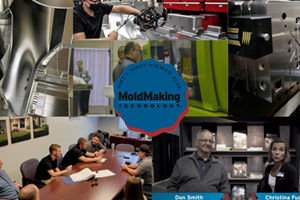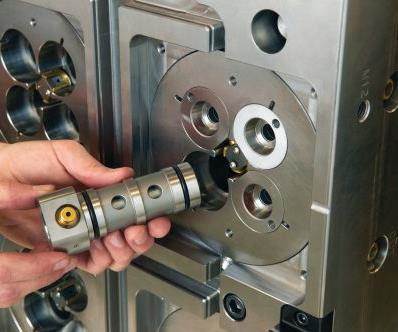In the Trenches: The Pitfalls of Press Work
Consider these factors when deciding on the location of a tool repair.
The term “press work” evokes a plethora of images, none of which are associated with pleasant thoughts or memories. A carpenter or an electrician may be perfectly happy plying his trade in varying locations other than in a shop, but your mechanic is not likely to meet you on the side of the highway to replace a CV bearing on your minivan. Similarly, mold repair is a trade best practiced on the bench, despite the fact that it happens all too often in the press.
As a supervisor, it is my call whether a repair will be attempted in the press or on the bench. I can’t give a decision matrix, but I can list four or five factors that I always weigh when faced with this dilemma.
One rule of thumb I’ve often preached to the bench technicians is that a repair that is expected to take more than 15 minutes should be done on the bench. But there is more wishful thinking in that statement than fact.
The fact is that pulling a mold (and subsequently, having to reset it) costs dearly in terms of productivity and man-hours. Mold setters aren’t sitting around waiting. They have other mold sets and pulls, which will be delayed if a tool has to be pulled for repair. Schedule shifting is another related fact. It can increase the possibility of missed shipments and result in the unrecoverable costs associated with repeating actions and with operators standing idly by waiting for parts to come down the conveyor.
The bottom line is that far more work ends up getting done in the press than any of us would like. However, there are cases where it is not absolutely essential that a mold be pulled, but it is nevertheless prudent to do so. Work in the press is unhandy at best and often downright awkward. When awkward borders on ridiculous or dangerous, it’s best to accept the losses and do the smart thing—repair the mold on the bench.
Danger, Danger
A standing lame joke is, “I can do it if you hang me by my ankles over the press.” When work is “out of position,” there are two dangerous concerns: ergonomics and making things worse.
Ergonomics. Imagine yourself standing in a tray of sheet metal parts with loose runners and slippery oil, with hard, sometimes sharp metal objects all around you, your tools balanced precariously on the tie bar or out of sight on top of a hot mold, and working under less-than–optimal lighting. Unless you have a gopher standing by (at an additional cost), every forgotten tool or piece of equipment requires a Houdini-esque escape from this dangerous little penalty box and a trip back to the toolroom.
Making things worse. The ergonomics required to polish a parting line hob on an upside-down vertical surface below your line of sight can cause your neck to ache, and you may cause worse damage to the mold you are trying to repair because you’re not able to clearly see exactly what you are doing. Slip and scratch a highly polished surface, and you can turn a half-hour job into an hour job, and there is no guarantee you won’t slip a second time.
Lessons Learned
The following scenario illustrates some of the pitfalls of press work. I recently got a call at home that a lifter at the shop would not go completely flush and that the processor dug some plastic out of the pocket for the lifter head. No problem, I thought. We’re dealing with a bent roll pin. I’ll be in and out of the shop in 15 minutes. I go in, report to the toolroom, and grab a hammer, a punch and some roll pins. What else could I possibly need, right? Well, it was three or four trips back to the toolroom and 45 minutes later before we actually shot a part.
Here are some lessons learned from that incident:
Take your crash cart to the work site. The punch I initially brought from the toolroom was the wrong size and went into the roll pin rather than push it. This forced me to go back to the toolroom to get a larger punch.
Understand that rigidity is your friend and vibration is a foe when removing stuck tooling. Although the lifter was attached to a 1-inch rod, it was extended far enough that vibration was an issue. Again, I had to go back to the toolroom and find an assortment of brass pieces to wedge under the head to stabilize it while I drove the roll pin out.
Protect adjacent tooling. Just as I have suggested in previous installments to use magnets and rags to protect surrounding areas from grinding debris, using a simple piece of cardboard would have prevented damage to a nearby lifter when the hammer glanced off the punch and hit that lifter. This led to yet another trip back to the toolroom to get basic polishing supplies (that, strangely enough, were also stored on my crash cart) so I could amend the damage to the second lifter.
As onerous as it may be, press work is a necessary evil and will never be completely eliminated. The old jest “Hurry up every chance you get” addresses the costliness of press downtime, but the warning “Take your time and do it right” may be more appropriate for work done in the less–than-ideal conditions that are typical of most in-press repairs.
Related Content
5 Hot Runner Tips for Moldmakers and Molders
Best practices for initial hot runner tryouts and effective preventive maintenance.
Read MoreMost-Viewed Content of 2022
The most popular MoldMaking Technology content according to analytics reports over the past 12 months.
Read MoreMoldMaking Technology's Most-Viewed Content 2022: Products
MMT shares the five top-viewed technologies, equipment and services of 2022 in each Engineer, Build, Maintain and Manage tenet based on Google Analytics.
Read MorePortable Low-Heat, Non-Arcing Resistance Welder for Mold Repair
Rocklin’s user-friendly MoldMender Micro Welder delivers simple and cost-effective localized repair in-house with precision and versatility, enhancing mold and die durability and reducing disassembly and downtime.
Read MoreRead Next
In the Trenches: Mold Repair
In this multi-part series of articles, contributer James Bourne, a tool repair supervisor and freelance writer, shares his own personal struggles in the business, as well as lessons learned and tricks of the trade garnered along the way.
Read MoreHow to Use Strategic Planning Tools, Data to Manage the Human Side of Business
Q&A with Marion Wells, MMT EAB member and founder of Human Asset Management.
Read MoreReasons to Use Fiber Lasers for Mold Cleaning
Fiber lasers offer a simplicity, speed, control and portability, minimizing mold cleaning risks.
Read More






.jpg;maxWidth=300;quality=90)

_300x250 4.png;maxWidth=300;quality=90)



















.jpg;maxWidth=970;quality=90)